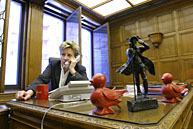Seagram Building reborn as Martlet House
Seagram Building reborn as Martlet House McGill University
User Tools (skip):
Seagram Building reborn as Martlet House
It's now official. The Peel Street castle, formerly known as the Seagram Company Ltd. headquarters, has been rechristened Martlet House.

Vice-Principal Nancy Wells in her office, once Sam Bronfman's own
Owen Egan
The unique office building was donated to the university in 2002 by Vivendi Universal, the global media and communications giant, which acquired the property after merging with Seagram, run by Montreal's Bronfman family.
The university spent $1.5 million renovating the site - everything from wiring to ventilation to carpets - before McGill's Development and Alumni Relations moved in last fall. But the landmark still didn't have an official name. Everyone referred to the structure as "the old Seagram building." Even the McGill phone directory listed the site by its old moniker.
Not anymore.
McGill's Senate Toponomy Subcommittee moved the Martlet House name from DAR's former Mountain Street mansion, now occupied by the Faculty of Medicine, since the Martlet marquee has stood above four alumni relations headquarters over 45 years. The Martlet designation was originally adopted from the three flying martlets featured on the university's coat of arms and a new sign should be posted on the Peel Street site within days.
With the Seagram sign now off the building constructed in 1928, the university pledged to preserve the structure's limestone façade as well as the second-floor boardroom. The same goes for the late Sam Bronfman's masculine and wood-paneled office.
Bronfman's majestic oak desk, stain-glass windows and massive oak chairs dominate the room - even his ashtray still sits on the windowsill - much as they did when the legendary tycoon ran his spirits empire until his 1971 death.
"One can almost feel the power and spirit of Mr. Bronfman in his office and imagine all the conversations that took place here," says Nancy Wells, DAR vice-principal, who now occupies the quarters. "It's a privilege to sit in this space, which was defined by a great Canadian, businessman and philanthropist."
Bronfman's Peel Street building was one of two Seagram headquarters; the main head office later relocated to New York City. The Montreal site was designed by architect David Jerome Spence to replicate a 16th-century Scottish baronial castle in tribute to the whiskey once produced by Seagram.
In 1931, Spence masterminded the building's first seamless addition, doubling its initial size. Two expansions followed in 1947 and 1955. Today, the building has five floors that provide McGill with 30,000 square feet of critical office space.
The building's restorations were conducted for McGill by Fournier Gersovitz Moss et Associés Architects. Julia Gersovitz, auxiliary professor of design at McGill's School of Architecture and a FGMAA partner, says it's not very often that an office building is modeled after a castle.
"While the building is not officially classified as a heritage monument," she says, "one can certainly argue it has heritage value: it is the work of an important Canadian architect, it is a landmark building and it was the headquarters of a famous international company."
Over the decades, Seagram and the Bronfman family have made several important contributions to McGill. Samuel Bronfman was a member of McGill's Board of Governors and his most significant gift was financing his eponymous Faculty of Management Building.
Other major gifts included the establishment of the McGill Institute for the Study of Canada, the Saidye Rosner Bronfman Chair in Architectural History, the Minda de Gunzburg Chair in Oncology (named after the late daughter of Saidye and Samuel Bronfman), and the Seagram Sports Science Centre.
About this most recent gift, son Charles Bronfman says: "My family is delighted to see our relationship with McGill continue with the donation of this Montreal landmark."
Wells is particularly happy the new Martlet House will house 100 full-and-part-time alumni and development staff previously scattered in several buildings: "We can now collaborate under one roof and we've gained a home at the heart of downtown that brings us closer to the Montreal community."
